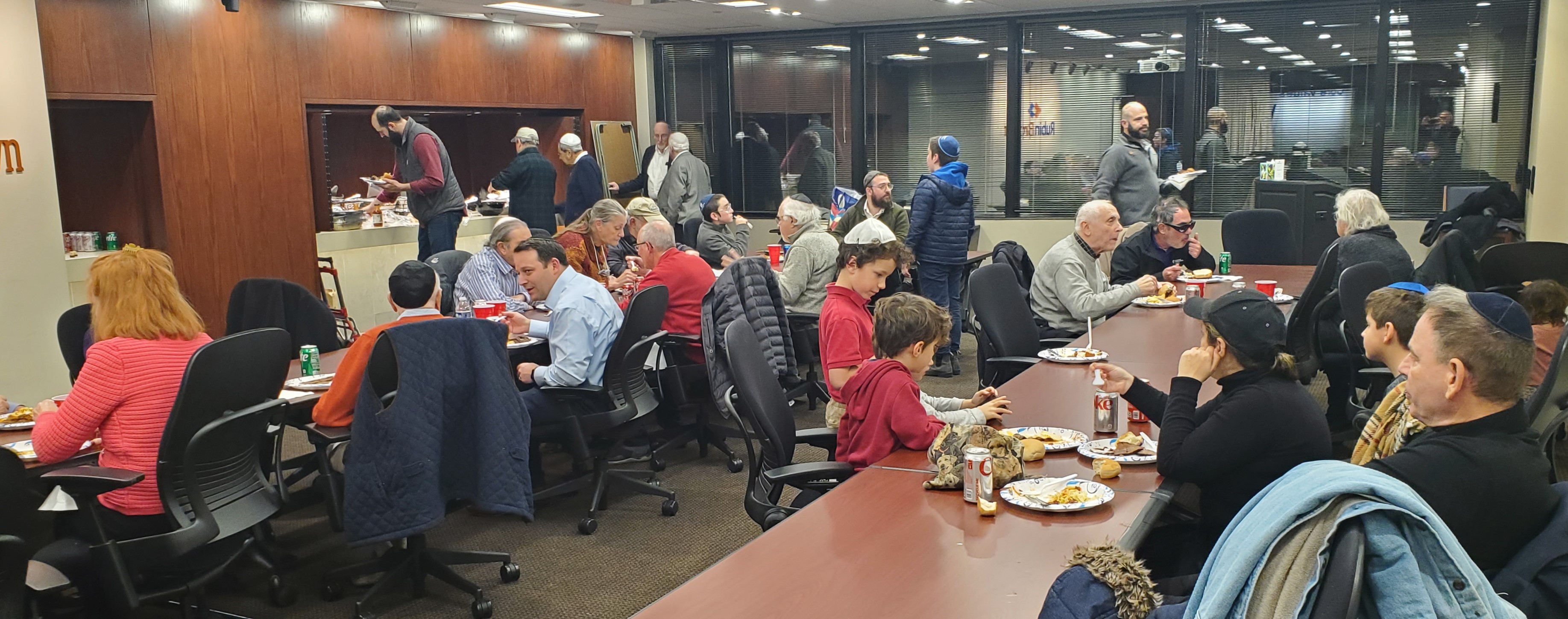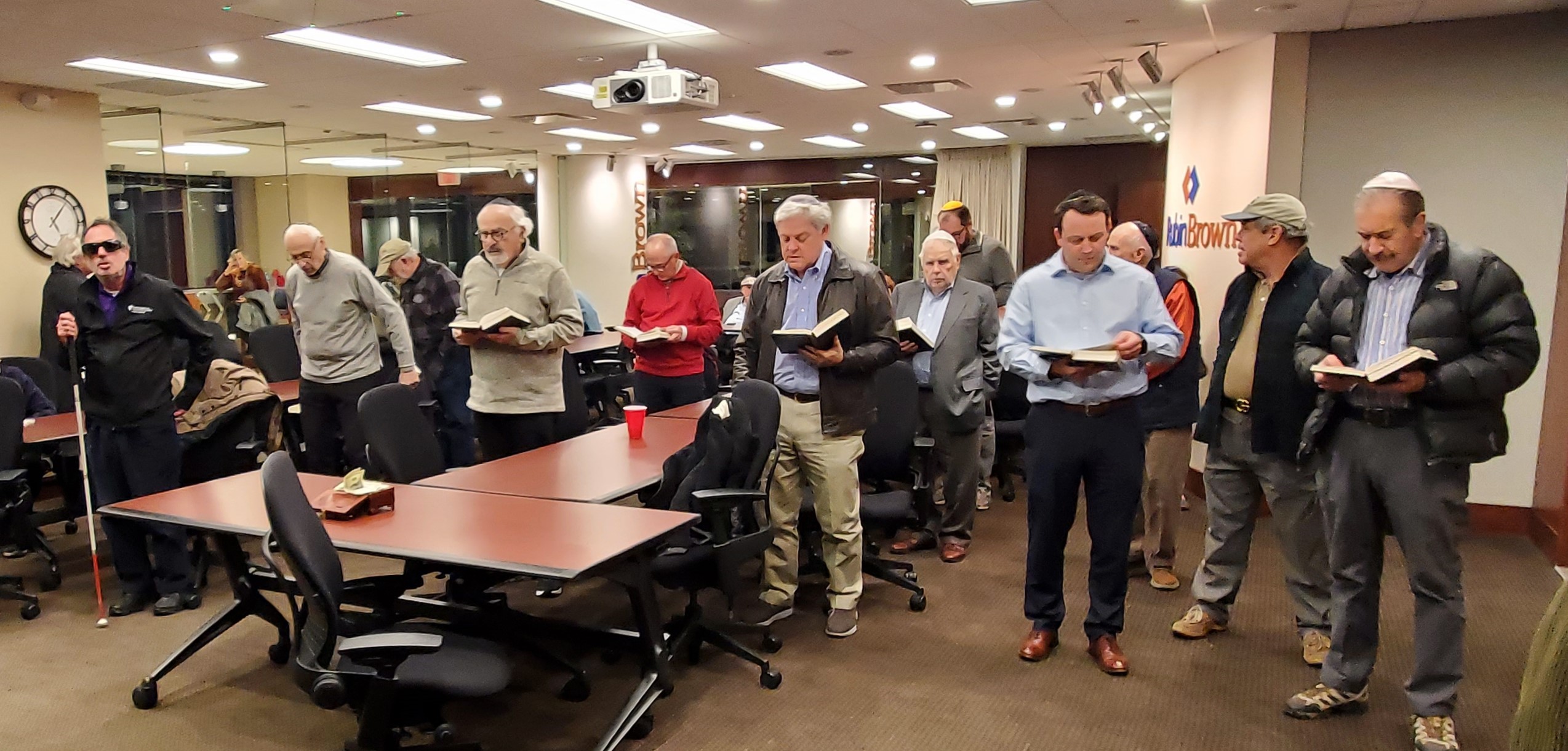Though it may take some “minyan wrangling,” at least 10 men meet nearly every Thursday as part of Kansas City’s Downtown Minyan. The group, largely led and organized by founders Paul Blackman and Max Jevinsky, recently celebrated its 20th anniversary.
Starting in November of 2004, Blackman and Jevinsky defied odds by creating and maintaining a regular minyan downtown — a Jewish asset that many other big cities do not have. The Downtown Minyan forms every Thursday (except for holidays) in the Harzfeld’s Building, with Jevinsky and Blackman estimating a regular attendance of about 12 to 14 men.
“We’re not very big,” Blackman said, “but we’re here, and we’ve been here a long time, and hopefully will still be here a long time.”
The Downtown Minyan’s 20th anniversary was celebrated during a dinner last month. Between the regular and occasional attendees and their families, Jevinsky and Blackman estimated nearly 40 people attended the celebration, which featured kosher barbecue.
Two decades of minyans
The seeds of the Downtown Minyan began in 2004 at Kehilath Israel Synagogue, when Blackman was saying Kaddish for his late father and Jevinsky was saying Kaddish for his late mother.
“We did not know each other, even though we were the same age and both attorneys downtown,” Blackman said. “There was no problem [coming to K.I. for a minyan] throughout the summer, but when November came around, we saw [a problem] coming.”
The problem was that when daylight saving time ended in November, the two would have to leave their jobs downtown in the mid-afternoon to make it to Mincha services at K.I. in Overland Park. They approached K.I.’s Rabbi Herbert Mandl about starting a minyan downtown, and he said that it was permissible by Jewish law, but similar ideas have failed in other cities.
“All you have to do is dare me that I can’t do something,” Blackman said about the motivation to establish the minyan.
“[The best way] to get something done is to tell him, ‘You can’t do it,’” Jevinsky said about Blackman.
The Downtown Minyan formed and continued strong throughout the winter. When daylight saving time restarted the following March, attendees held a vote to continue gathering year-round.
“The reason they voted for that wasn’t religious at all,” Blackman said. “...They didn’t want to break up the group. They were fearful that if we stopped in March or April of 2005, we would never resume again. The camaraderie was such an esprit de corps that they wanted to keep the group together.”
The Downtown Minyan continued throughout 2005 and into the current day. In 2014, upon the Downtown Minyan’s 10th anniversary, Rabbi Mandl told The Chronicle, “I’m tickled pink that it worked.”
The group calls itself B’nai Bryant because it was originally held in the Bryant Building on 11th and Grand, where Blackman’s law office was. It later moved to the Palace Clothing Company Building and then to the Harzfeld’s Building at 1111 Main Street, where it still meets today.
Jevinsky said that in the early days of B’nai Bryant, most minyan attendees were within walking distance, if not working in the same building already. It wasn’t difficult to secure 10 men.
Minyans used to gather multiple times a week, but after a 16-month hiatus during the COVID-19 pandemic, minyans are now only held on Thursdays. Herring and schnapps are often served. During fast days when the Torah must be read, Blackman picks up a Torah from K.I., and Rabbi Yitzchak Itkin of Chabad on the Plaza (who is a regular attendee) reads.
Additional gatherings include Passover Chol HaMoed lunches and annual anniversary dinners with kosher barbecue.
Continuing strong today
Jevinsky and Blackman’s drive to maintain a Jewish presence downtown is a main reason B’nai Bryant still exists today.
“It’s important to me to have a Jewish presence in the central city,” Blackman said. “So many of our institutions, including The Chronicle [and] most of the synagogues, have left for Johnson County… Kansas City, Missouri, is still a central community. It’s the anchor of the metropolitan area, and so I want there to be a Jewish influence.”
There is a risk of not having enough men for a minyan some Thursdays, despite Rabbi Itkin, young people and Jewish travelers coming regularly in addition to longtime attendees. In order to reduce the risk of not getting 10 men, Jevinsky and Blackman often “minyan wrangle” to ensure attendance. Jevinsky keeps a thorough record of attendees going back years as well as a list of people who say they’ll attend if needed.
“I’m quite certain that if we didn’t do the wrangling, then at 5 p.m. on Thursday afternoons, nobody would show up,” Jevinsky said.
“I wear the moniker of ‘the noodge,’” Blackman said. “But you can only [noodge] in a kind and friendly fashion, and you can’t be overbearing. You can’t lay guilt on anybody.”
Friendliness and camaraderie are key aspects of B’nai Bryant, as is charity. A tzedakah box is present at every minyan, and Jevinsky estimates that over 20 years, the group has donated about $25,000 to many different charities. When anybody connected to B’nai Bryant dies, the group donates $150 to the charity of the deceased’s family’s choice.
With two decades stewarding B’nai Bryant under their belt, Jevinsky and Blackman hope that the group continues well into the future.
“I would like this to continue on,” Blackman said. “I don’t want this to just be ‘the Paul and Max show,’ so when we’re gone, it’s gone. I hope [B’nai Bryant] is a permanent part of Jewish presence in the central city.”

Attendees of the Downtown Minyan and their families at the group’s 20th anniversary celebration on Dec. 12.



